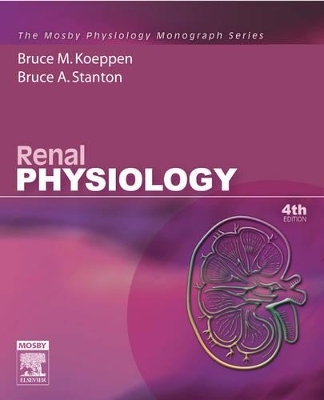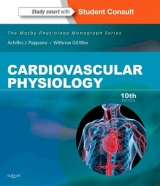
Renal Physiology
Mosby
978-0-323-03447-0 (ISBN)
- Titel erscheint in neuer Auflage
- Artikel merken
"The Mosby Physiology Monograph Series" offers the fundamentals of body systems physiology in a clear and concise manner. Each volume in the series is written by experts in the field for an authoritative, yet readable introduction to the physiology relevant to a particular organ system.This new 4th edition of "Renal Physiology" offers: clear, accurate and up-to-the-minute coverage of the physiology of the renal system focusing on the needs of the student; pathophysiology content throughout that serves as a bridge between normal function and disease; and, integrated student-friendly tools, including learning objectives, overview boxes, key words and concepts, chapter summaries, self-study problems, clinical cases with questions and explained answers, clinical boxes and molecular boxes. Access to Student Consult[registered] is an innovative website that allows you to build a personalized, fully integrated, online library, where you'll find the entire contents of every "Student Consult" title purchased, integration links to bonus content in other "Student Consult" titles, and much more.
Introduction to the Kidney 1Physiology of Body Fluids OBJECTIVES PHYSICOCHEMICAL PROPERTIES OF ELECTROLYTE SOLUTIONS Molarity and Equivalence Osmosis and Osmotic Pressure Osmolarity and Osmolality Tonicity Oncotic Pressure Specific Gravity VOLUMES OF BODY FLUID COMPARTMENTS COMPOSITION OF BODY FLUID COMPARTMENTS FLUID EXCHANGE BETWEEN BODY FLUID COMPARTMENTS Capillary Fluid Exchange Cellular Fluid Exchange SUMMARY KEY WORDS AND CONCEPTS SELF-STUDY PROBLEMS 2Structure and Function of the Kidneys OBJECTIVES STRUCTURE OF THE KIDNEYS Gross Anatomy Ultrastructure of the Nephron Ultrastructure of the Renal Corpuscle Ultrastructure of the Juxtaglomerular Apparatus Innervation of the Kidneys SUMMARY KEY WORDS AND CONCEPTS SELF-STUDY PROBLEMS 3Glomerular Filtration and Renal Blood Flow OBJECTIVES RENAL CLEARANCE Glomerular Filtration Rate GLOMERULAR FILTRATION Determinants of Ultrafiltrate Composition Dynamics of Ultrafiltration RENAL BLOOD FLOW REGULATION OF RENAL BLOODS FLOW AND GLOMERULAR FILTRATION RATE Sympathetic Nerves Angiotensin II Prostaglandins Nitric Oxide Endothelin Bradykinin Adenosine Natriuretic Peptides ATP Glucocorticoids Histamine Dopamine SUMMARY KEY WORDS AND CONCEPTS SELF-STUDY PROBLEMS 4Renal Transport Mechanisms: NaCl and Water Transport Along the Nephron OBJECTIVES GENERAL PRINCIPLES OF MEMBRANE TRANSPORT GENERAL PRINCIPLES OF TRANSEPITHELIAL SOLUTE AND WATER TRANSPORT NaCl, SOLUTE, AND WATER REABSORPTION ALONG THE NEPHRON Proximal Tubule Henle's Loop Distal Tubule and Collecting Duct REGULATION OF NaCL AND WATER REABSORPTION SUMMARY KEY WORDS AND CONCEPTS SELF-STUDY PROBLEMS 5Regulation of Body Fluid Osmolality: Regulation of Water Balance OBJECTIVES ANTIDIURETIC HORMONE Osmotic Control of ADH Secretion Hemodynamic Control of ADH Secretion ADH Actions on the Kidneys THIRST RENAL MECHANISMS FOR DILUTION AND CONCENTRATION OF THE URINE Medullary Interstitium Vasa Recta Function ASSESSMENT OF RENAL DILUTING AND CONCENTRATING ABILITY SUMMARY KEY WORDS AND CONCEPTS SELF-STUDY PROBLEMS 6Regulation of Extracellular Fluid Volume and NaCl Balance OBJECTIVES CONCEPT OF EFFECTIVE CIRCULATING VOLUME VOLUME-SENSING SYSTEMS Vascular Low-Pressure Volume Sensors Vascular High-Pressure Volume Sensors Hepatic Sensors Central Nervous System Na+ Sensors Volume Sensor Signals Renal Sympathetic Nerves Renin-Angiotensin-Aldosterone System Natriuretic Peptides Antidiuretic Hormone CONTROL OF RENAL NaCL EXCRETION DURING EUVOLEMIA Mechanisms for Maintaining the Delivery of Na+ to the Distal Tubule Constant Regulation of Distal Tubule and Collecting Duct Na+ Reabsorption CONTROL OF Na+ EXCRETION WITH VOLUME EXPANSION CONTROL OF Na+ EXCRETION WITH VOLUME CONTRACTION EDEMA Alterations in Starling Forces The Role of the Kidneys SUMMARY KEY WORDS AND CONCEPTS SELF-STUDY PROBLEMS 7Regulation of Potassium Balance OBJECTIVES OVERVIEW OF K+ HOMEOSTASIS REGULATION OF PLASMA [K+] Epinephrine Insulin Aldosterone ALTERATIONS OF PLASMA [K+] Acid-Base Balance Plasma Osmolality Cell Lysis Exercise K+ EXCRETION BY THE KIDNEYS CELLULAR MECHANISMS OF K+ SECRETION BY PRINCIPAL CELLS IN THE DISTAL TUBULE AND COLLECTING DUCT REGULATION OF K+ SECRETION BY THE DISTAL TUBULE AND COLLECTING DUCT Plasma [K+] Aldosterone Antidiuretic Hormone FACTORS THAT PERTURB K+ EXCRETION Flow of Tubular Fluid Acid-Base Balance Glucocorticoids SUMMARY KEY WORDS AND CONCEPTS SELF-STUDY PROBLEMS 8Regulation of Acid-Base Balance OBJECTIVES THE HCO3- BUFFER SYSTEM OVERVIEW OF ACID-BASE BALANCE NET ACID EXCRETION BY THE KIDNEYS HCO3- REABSORPTION ALONG THE NEPHRON REGULATION OF H+ SECRETION Formation of New HCO3- RESPONSE TO ACID-BASE DISORDERS Extracellular and Intracellular Buffers Respiratory Compensation Renal Compensation SIMPLE ACID-BASE DISORDERS Metabolic Acidosis Metabolic Alkalosis Respiratory Acidosis Respiratory Alkalosis ANALYSIS OF ACID-BASE DISORDERS SUMMARY KEY WORDS AND CONCEPTS SELF-STUDY PROBLEMS 9Regulation of Calcium and Phosphate Homeostasis OBJECTIVES CALCIUM Overview of Ca++ Homeostasis Ca++ Transport along the Nephron Regulation of Urinary Ca++ Excretion Calcium-Sensing Receptor PHOSPHATE Overview of Pi Homeostasis Pi Transport along the Nephron Regulation of Urinary Pi Excretion INTEGRATIVE REVIEW OF PARATHYROID HORMONE, CALCITRIOL, AND CALCITONIN ON Ca++ AND PI HOMEOSTASIS SUMMARY KEY WORDS AND CONCEPTS SELF-STUDY PROBLEMS 10Physiology of Diuretic Action OBJECTIVES GENERAL PRINCIPLES OF DIURETIC ACTION Sites of Action of Diuretics Response of Other Nephron Segments Adequate Delivery of Diuretics to Their Site of Action Volume of the Extracellular Fluid DIURETIC BRAKING PHENOMENON MECHANISMS OF ACTION OF DIURETICS Osmotic Diuretics Carbonic Anhydrase Inhibitors Loop Diuretics Thiazide Diuretics K+-Sparing Diuretics Aquaretics EFFECT OF DIURETICS ON THE EXCRETION OF WATER AND OTHER SOLUTES Solute-Free Water K+ Excretion HCO3- Excretion Ca++ and Pi Excretion SUMMARY KEY WORDS AND CONCEPTS SELF-STUDY PROBLEMS Additional Reading APPENDIX A Integrative Case Studies APPENDIX B Normal Laboratory Values APPENDIX C Nephron Function APPENDIX D Answers to Self-Study Problems APPENDIX E Answers to Integrative Case Studies APPENDIX F Review Examination Index
| Erscheint lt. Verlag | 1.10.2006 |
|---|---|
| Reihe/Serie | Mosby's Physiology Monograph |
| Zusatzinfo | Approx. 100 illustrations |
| Verlagsort | St Louis |
| Sprache | englisch |
| Maße | 191 x 235 mm |
| Themenwelt | Medizinische Fachgebiete ► Innere Medizin ► Nephrologie |
| Studium ► 1. Studienabschnitt (Vorklinik) ► Physiologie | |
| ISBN-10 | 0-323-03447-0 / 0323034470 |
| ISBN-13 | 978-0-323-03447-0 / 9780323034470 |
| Zustand | Neuware |
| Haben Sie eine Frage zum Produkt? |
